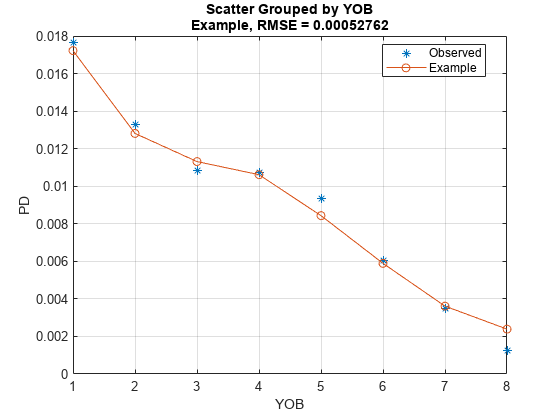modelCalibrationPlot
Plot observed default rates compared to predicted PDs on grouped data
Since R2023a
Syntax
Description
modelCalibrationPlot(
plots the observed default rates compared to the predicted probabilities of default
(PD). pdModel,data,GroupBy)GroupBy is required and can be any column in the
data input (not necessarily a model variable). The
modelCalibrationPlot function computes the observed PD as the
default rate of each group and the predicted PD as the average PD for each group.
modelCalibrationPlot supports comparison against a reference
model.
modelCalibrationPlot(___,
specifies options using one or more name-value pair arguments in addition to the
input arguments in the previous syntax.Name,Value)
h = modelCalibrationPlot(ax,___,Name,Value)h.
Examples
Input Arguments
Name-Value Arguments
Output Arguments
More About
References
[1] Baesens, Bart, Daniel Roesch, and Harald Scheule. Credit Risk Analytics: Measurement Techniques, Applications, and Examples in SAS. Wiley, 2016.
[2] Bellini, Tiziano. IFRS 9 and CECL Credit Risk Modelling and Validation: A Practical Guide with Examples Worked in R and SAS. San Diego, CA: Elsevier, 2019.
[3] Breeden, Joseph. Living with CECL: The Modeling Dictionary. Santa Fe, NM: Prescient Models LLC, 2018.
[4] Roesch, Daniel and Harald Scheule. Deep Credit Risk: Machine Learning with Python. Independently published, 2020.
Version History
Introduced in R2023a
See Also
modelDiscrimination | modelDiscriminationPlot | modelCalibration | predictLifetime | predict | fitLifetimePDModel | Logistic | Probit | Cox | customLifetimePDModel
Topics
- Basic Lifetime PD Model Validation
- Compare Logistic Model for Lifetime PD to Champion Model
- Compare Lifetime PD Models Using Cross-Validation
- Expected Credit Loss Computation
- Compare Model Discrimination and Model Calibration to Validate of Probability of Default
- Compare Probability of Default Using Through-the-Cycle and Point-in-Time Models
- Overview of Lifetime Probability of Default Models
